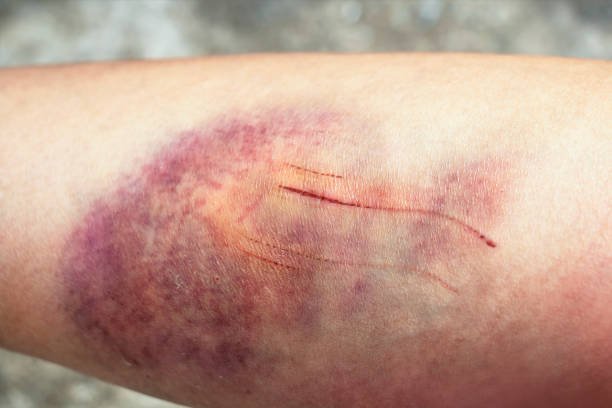Leukemia can cause skin problems like rashes and bruises. There are different kinds of rashes, like petechiae and purpura, which happen when tiny blood vessels under the skin break. Some rashes have little bumps or nodules on the skin.
Leukemia is a kind of blood cancer that starts in your bone marrow, the place where your body makes blood cells. It makes your body produce too many abnormal white blood cells.
White blood cells usually protect your body from infections. But in leukemia, these messed-up white blood cells take up space and push out the healthy blood cells. This can lead to skin problems.
In 2018, about 459,058 people had leukemia in the United States, according to the National Cancer Institute (NCI).
In 2018, the number of new cases of leukemia for every 100,000 people were:
- 16.5 for white people who are not Hispanic
- 11.4 for Black people (including Hispanic)
- 11.4 for Hispanic people (of any race)
- 11.2 for American Indian/Alaska Native people (including Hispanic)
- 8.8 for Asian/Pacific Islander people (including Hispanic)
Common Signs of Leukemia
When leukemia affects your red blood cells, you might feel tired, get paler, have trouble breathing, and develop anemia. If your white blood cell count is low, your ability to fight off infections goes down, and you might get sick more often. When your platelets are involved, your ability to clot blood is affected, which can make you bruise and bleed more easily.
As the disease gets worse, you might also experience chills, fever, nosebleeds, small red spots on your skin that look like raised red and purple speckles, swollen or bleeding gums, weight loss, and achy joints and bones.
More Symptoms of Leukemia
Besides a rash, leukemia can bring about various other symptoms like:
- Getting bruises and bleeding easily.
- Having a fever.
- Getting sick often.
- Feeling weak due to anemia (not having enough healthy red blood cells).
- Experiencing pain in your bones or joints.
- Feeling really tired.
- Losing weight without trying.
- Having trouble catching your breath.
- Having pale skin.
What Are Signs of Cancer Related to Blood?
- Getting many bruises in places where you didn’t bump into anything.
- Small red spots that group together on your lower legs and feet.
- Feeling very tired.
- Having fevers.
- Getting really sweaty at night.
- Losing weight without trying.
- Having swollen glands.
Bleeding and Bruising in People with Cancer
People with cancer often experience issues with bleeding and bruising.
When it comes to bleeding problems, this can show up as frequent or heavy nosebleeds, bleeding gums, vomiting or urinating blood, or blood in the stool (which can be bright red or look like sticky tar). Women with cancer may also have spotting or bleeding from their vagina.
For bruising problems, these individuals might get bruises that are larger and more severe than usual. They could even develop hematomas, which are like lumps under the skin. If their platelet levels are low, they might notice tiny red spots gathering together, almost like a rash on their legs, buttocks, or where a blood pressure cuff or tourniquet was used on their arm. These spots are called petechiae.
Low Platelets and Bleeding in Cancer
People with cancer may face problems like bleeding and bruising, often due to low blood platelet counts, which is known as thrombocytopenia.
Platelets are crucial for helping the blood clot when needed. Cancer patients, especially those getting treatments like chemotherapy or radiation affecting their bone marrow, are more likely to develop thrombocytopenia. To manage this, doctors use platelet transfusions.
Blood Clotting Issues and Cancer
Troubles with bleeding and bruising can also be because of something called a coagulopathy. Coagulopathies are conditions where the blood is missing certain special proteins necessary for clotting, called clotting factors.
One common coagulopathy in people with cancer is not having enough vitamin K due to poor eating habits. Antibiotics or problems with the bowel can also lead to a lack of vitamin K. Because the liver has a big role in making clotting factors, patients with liver diseases, including liver cancer, are at risk for coagulopathies. People taking blood-thinning medications may also have bleeding and bruising problems because these drugs affect how blood normally clots.
To treat coagulopathies, doctors can replace vitamin K or the missing clotting factors using plasma or clotting concentrates. Bleeding caused by most blood-thinning medications can be treated with specific antidotes.
How Common is Leukemia?
In the United States, about 14 out of every 100,000 men and women are diagnosed with leukemia each year, which adds up to around 61,000 new cases annually, according to the National Cancer Institute. Leukemia ranks as the 10th most common cancer in the U.S.
Leukemia can be either acute or chronic. It’s more common in older people, especially those in their 60s and beyond. Acute leukemia can develop rapidly, while acute myelogenous leukemia (AML) is the most common type in adults, and acute lymphocytic leukemia is common in children and younger adults.
Chronic lymphocytic leukemia (CLL) is the most common form of non-acute leukemia, while chronic myelogenous leukemia (CML) is less common.
How is Leukemia Diagnosed?
If you experience any of the symptoms mentioned earlier and they don’t go away or get worse, you should see your doctor for an evaluation. Leukemia is suspected, your doctor will order a complete blood count to check your blood cells. If the counts are abnormal, a bone marrow biopsy may be done to confirm the diagnosis. You might also undergo CT or MRI scans to look for cancer in your lymph nodes and organs.
Treatment for Leukemia
The usual treatment for acute leukemia is chemotherapy. In some cases, if chemotherapy doesn’t work or for certain subtypes of acute leukemia, a stem cell transplant may be an option. This procedure involves receiving healthy stem cells from a donor. Chronic leukemia is typically treated with newer therapies designed to target cancer cells.
Unfortunately, there are no routine tests to catch leukemia early. In most cases, there are no clear risk factors, but older adults have a higher risk. You might have a slightly increased risk if a family member has had leukemia, or if you’ve been exposed to chemicals like benzene (found in crude oil, rubber, and dye), smoked cigarettes, or been exposed to chemotherapy or radiation.
When should you worry?
If you see bruises or rashes on your body, don’t panic right away. In most cases, it’s not a big problem. But that’s the tricky part about leukemia – its signs can look like regular illnesses. If you get bruises a lot or they don’t go away, it’s a good idea to talk to your doctor.
It’s important to know what other signs leukemia might bring, so you can decide to see your doctor sooner and get a blood test. Connect the dots between leukemia symptoms and catch it early.
Questions People Often Ask About Leukemia Skin Issues
1. Can Bruising Be a Sign of Cancer?
Yes, it can. Many people with acute leukemia go to the doctor because they have new bruising and tiny red spots on their skin.
2. Which Cancers Can Cause Bruising?
Cancers like leukemia, lymphomas, and myeloma can lead to flat bruises (ecchymoses) and red spots (petechiae). Patients with primary and metastatic liver cancer, as well as those getting blood-thinning medications, might get lumpy bruises (hematomas).
3. What Does a Cancer Bruise Look Like?
A cancer bruise looks like a regular bruise. It usually changes from reddish purple to brownish over about 10 days. It often has smooth edges and lies flat.
4. How About a Leukemia Bruise?
A single leukemia bruise looks like any other bruise. The difference is that leukemia bruises keep appearing and spreading. They are flat and often come with small red spots on the feet and ankles.
5. When Should I See a Doctor About Unexplained Bruising?
If bruises keep showing up in new places or if bruising comes with bleeding, petechiae, fatigue, fevers, night sweats, weight loss, or swollen glands, it’s a good idea to see a doctor. A few simple blood tests can check for low platelet counts or clotting problems.


